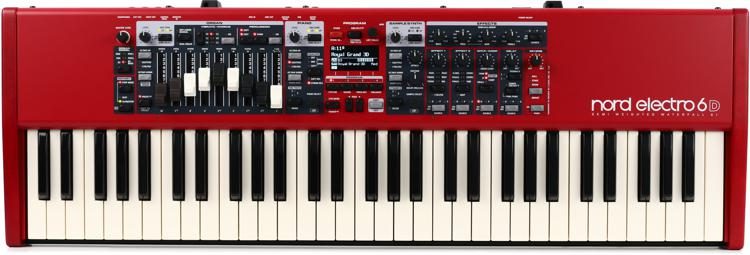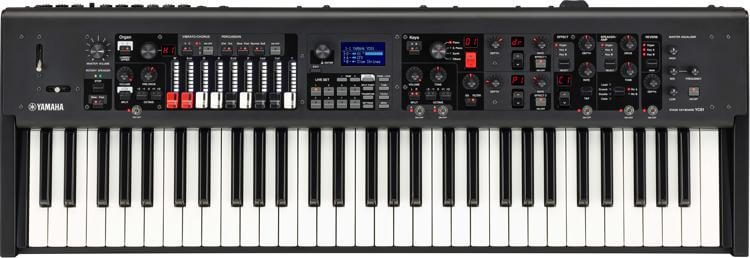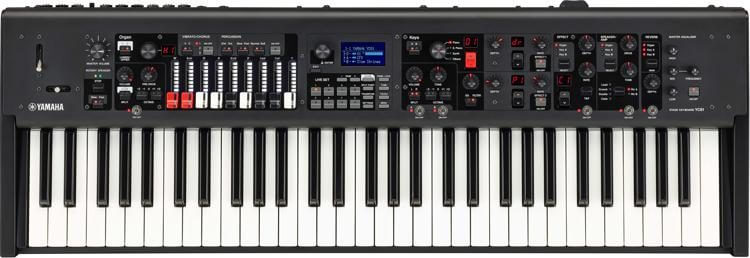*Keyboardkraze now has a nearly 24/7 chat service directly with me should you have any questions regarding keyboard/plugin choices! This is connected directly to me and it is not AI.
Table of Contents
The Yamaha YC61 was recently announced at the 2020 NAMM music conference and it instantly had the keyboard community talking.
My first thoughts are that I really like the appearance of it. It resembles the Yamaha CP 88 and I was beyond ecstatic on the CP88.
This keyboard is basically Yamaha’s answer to the Nord Electro series. I believe that Yamaha has stepped up their game with their release of the Yamaha CP 88 and that is also my hope for the YC61.
The YC61 is a sound designers dream. It is equipped with amazing organs as well as beautiful piano sounds. The keys have been created so that they also don't cut your fingers, which is nice.
My opinion on the YC61 is that it is one of the 61 key stage piano options currently on the market. I believe that this is a win over the Nord Electro. With this being said, there are a couple of arguments against the Yamaha YC61 that we will dive into below.
Features
- Type: 61 key drawbar organ/digital piano
- Virtual circuit modeling to capture vintage organ feel
- Drawbars: 9
- Keybed: waterfall
- Controllers: pitch-bend lever, pitch-modulation lever
- Effects: Nine effects including delay, reverb, vibrato rotary speaker
- 2-channel USB audio interface
- MIDI I/O: Yes
- Weight: 15.6 pounds
- Soft Case Included
Pros
- Interface
- Incredible Sounds
- Authentic feeling drawbars
- Waterfall keybed
- Great MIDI functionality
- LCD screen
- Live set mode
- Light-weight
- Great for gigging
- Digital organ with pitch-bend & pitch modulation
- 128 note polyphony
- Virtual Circuitry Modeling
- 8 operator FM synthesis
- 2 Rotary Speakers
Cons
- Expensive
- Lacks polyphonic aftertouch
Yamaha YC 61 Overview
I personally find the layout and design of the Yamaha YC 61 to be great. It is similar to the famous Nord Electro series, however, I think I prefer the Yamaha YC 61 layout more.

I think that Yamaha definitely took note of the Electro series as it has been so popular for so many years. With this being said, I think that was a smart move on their part.
The Yamaha YC61 has 8 more notes of polyphony than the Electro, coming in at 128 note polyphony.
Design
The Yamaha YC 61 has some great features for a digital organ/stage piano. The top left of the keyboard displays a pitch-bend lever and a modulation lever. I find this to be extremely interesting.
The Nord Electro is missing and kind of pitch-bend and modulation and that has always been a knock on it. This is an area that Yamaha nailed in my opinion.
While I’m a fan of the wheels usually more than levers, I really like the design and idea of the levers.
Great For Gigging Keyboardists
If you’re someone who utilizes organs, pianos, & strings and doesn’t use a ton of synths, this is an incredible option. This keyboard is lightweight, weighing only 15 pounds, yet it still feels durable.
Keyboardists who play gospel or jazz will most likely fall for the Yamaha YC 61, especially if you enjoy the Nord Electro. The sounds were nailed right on the head in my opinion and you get a sense of nostalgia while playing electric organs.
The drawbars are durable and they don’t hurt your fingers while sliding them up and down. This is a big plus in my opinion.
Even if you’re a keyboardist who uses MIDI controllers, I think that this would be a great additional keyboard for gigging to nail your organs and piano sounds.
Keybed
The waterfall keybed of the YC61 was designed to match the traditional feel of organ keyboards. If you’ve ever played on an organ, you will notice that the keys are completely different than those of digital pianos.
The keybed feels great and I believe that Yamaha knocked this area out of the park for playability. This keybed allows the musician to play with authenticity and it is designed to have the musician use expressive organ techniques while playing.
The keys on the YC 61 were created with rounded edges. I think this is a really smart call as one thing I have always disliked with organs is the fear of slicing my fingers with glissandos.
The keys on traditional organs are extremely sharp and you can really do some damage to your fingers if you’re not careful. The YC 61 excels majorly in this department.
Drawbars

The drawbars are a big win for the YC 61. They feel authentic and reliable. You don’t get the feeling that you’re going to break them, which allows you to slide them and play with as much as feeling as you would wish.
The edges of the drawbars are rounded out, rather than feel pointy. This was done to avoid the potential of cutting your fingers.
You are given 9 different drawbars that all feel very durable.
Shortcomings
To be honest, there aren’t many things that I feel like could be improved with the YC61. The one thing that does jump out at me is the lack of polyphonic aftertouch.
Sounds
The YC 61 has some incredible sounds thanks to the virtual circuit modeling. This was originally developed by Yamaha for the “add-on effects” for their digital mixers. The point of VCM is to digitally emulate analog gear all the way down to the individual component level.
As far as the actual sounds, the electric pianos and organs sound incredibly warm and deep to me. You can hone in on some seriously fat-sounding organs that I personally can’t get enough of.
61 Keys For Portability
There are keyboardists who are being harsh on the fact that this keyboard only has 61 keys. The reason why it has 61 keys is for portability. While this can be limiting, depending on what you’re looking to do, I believe that 61 keys is still plenty for most musicians.
A keyboard with this kind of power and a weight of only 15 pounds is extremely impressive to me. You can also run it as a MIDI controller if you’re wanting to dive into more sounds.
Overall
The Yamaha YC 61 is a digital powerhouse that might be the most powerful digital organ currently available. Yamaha pushed the envelope further than other companies with certain features like the pitch-bend lever, the pitch-modulation lever, and the VCM.
I think that I would lean towards this over the Nord Electro as it is a little cheaper and I believe it sounds better overall.
What are your thoughts of the YC 61? Let me know in the comments below.










2 comments
Loved u r review but how many sounds does this keyboard have ?? Organ and 2pianos? Can u program this keyboard and what about any bugs this keyboard might have coming out of the blocks … I have a modx 7 that I like but there r a few bugs 🐛 in it , such as scene info not stored , and in the chromatic/perc tab the keyboard emitted just touch data. No tamber ( sound ) after being programmed . No I am not a weekend warrior and play music fulltime . I am a little worried about a new product with no track record ….. thank for reading 😎
Your comment about the YC being used as a controller. when gigging it’s much better to have the options on board the keyboard itself rather than fooling with software and possible interruptions between computer and keyboard during a performance. advantage the Nord comes with a package where you can download and organize all sounds in order preselected from their website. Otherwise, all you need a inexpensive controller – you probably should go with a cheaper low-cost unit and bring all your software with you. it just comes down to if you really like the instrument sound when choosing between electro or YC. that’s just my opinion. that said, I love my mox 6. 8 years and no problems.